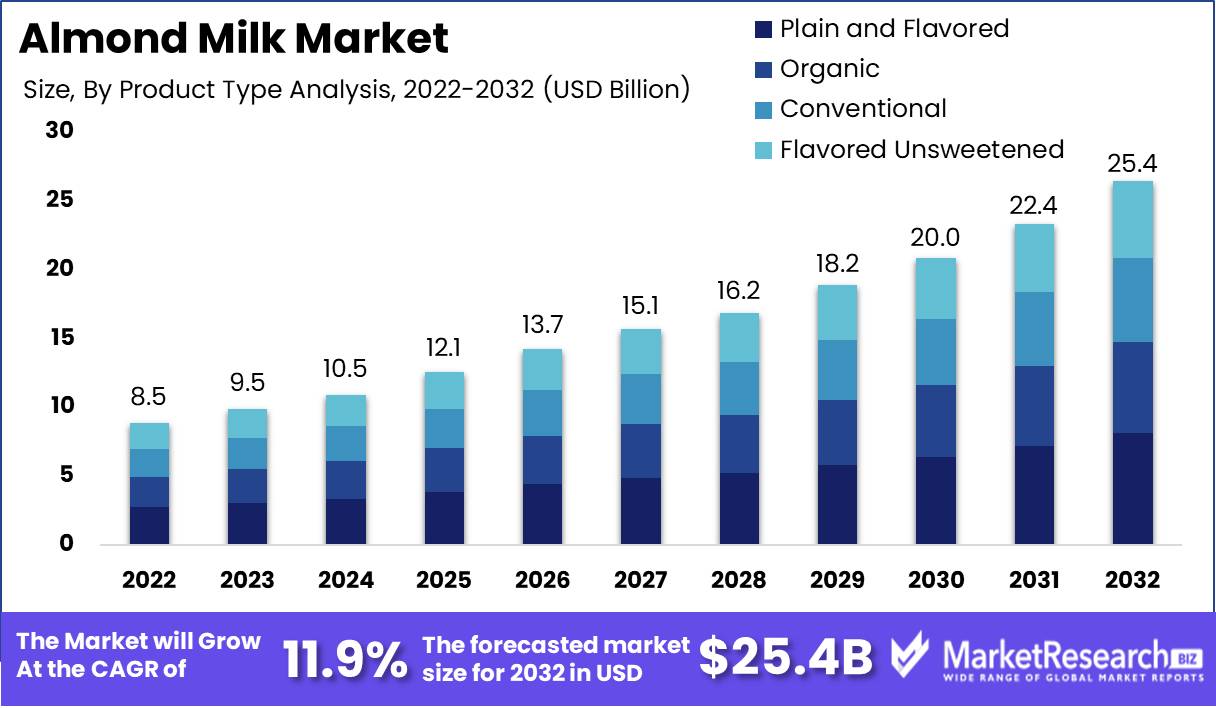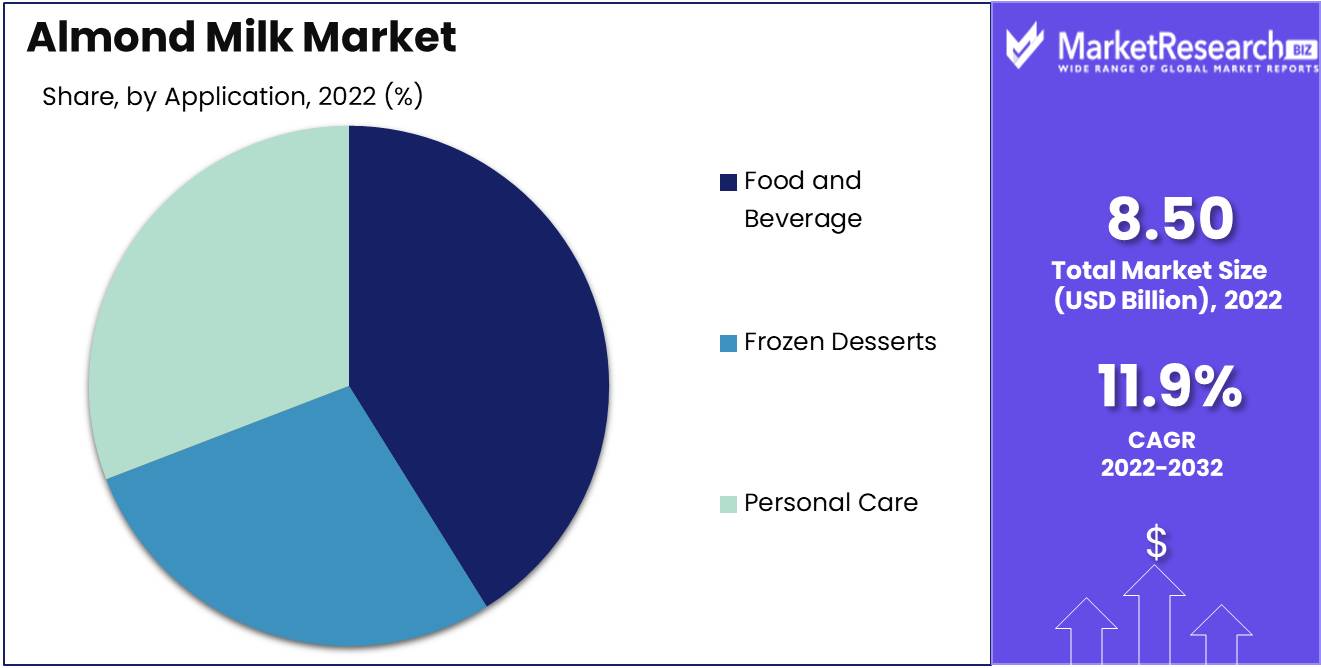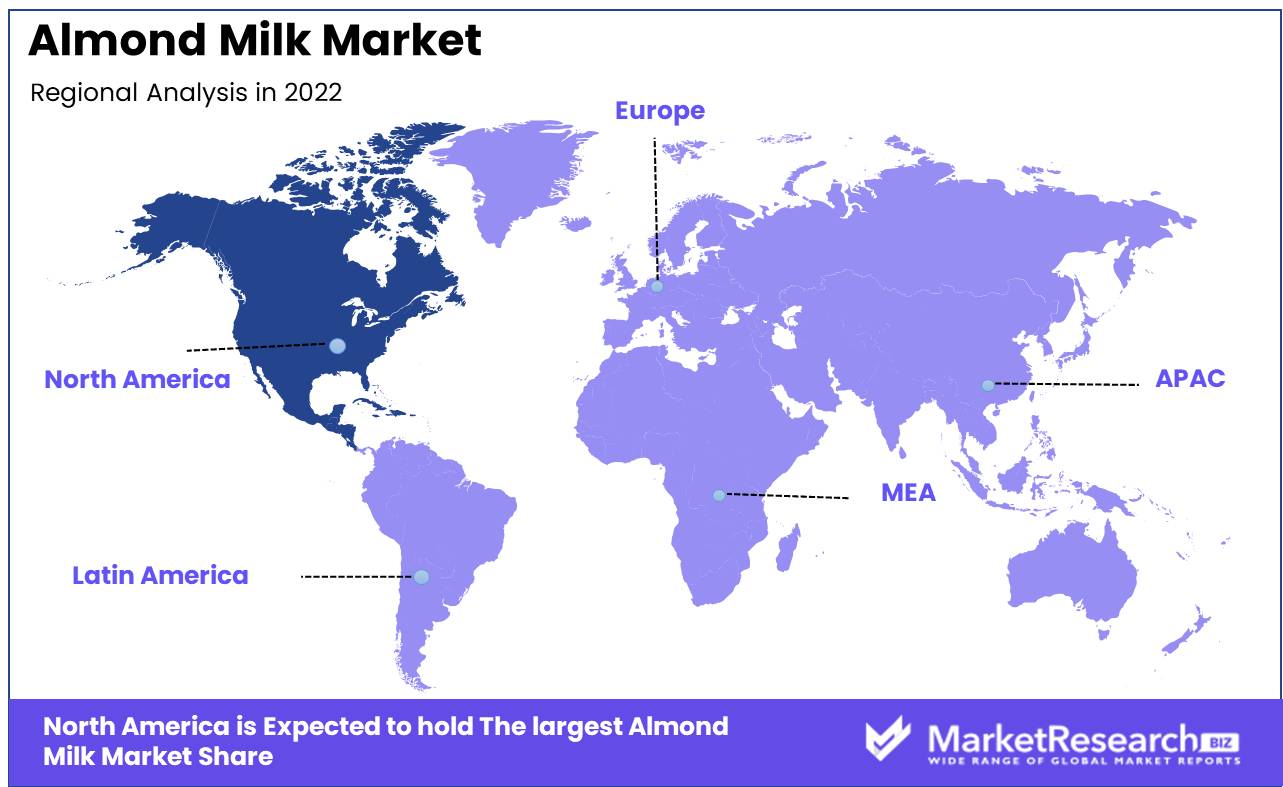
Global Almond Milk Market By Product Type Analysis (plain and flavored, Organic, Others), By Packaging Analysis (cartons,Glass, Bottles, Others), By Distribution Channel Analysis (Hypermarkets/Supermarkets, Convenience Stores, Others), By Application Analysis (Food and Beverage, Frozen Desserts, Others) By Region And Companies - Industry Segment Outlook, Market Assessment, Competition Scenario, Trends, And Forecast 2023-2032
-
11767
-
May 2023
-
183
-
-
This report was compiled by Shreyas Rokade Shreyas Rokade is a seasoned Research Analyst with CMFE, bringing extensive expertise in market research and consulting, with a strong background in Chemical Engineering. Correspondence Team Lead-CMFE Linkedin | Detailed Market research Methodology Our methodology involves a mix of primary research, including interviews with leading mental health experts, and secondary research from reputable medical journals and databases. View Detailed Methodology Page
-
Quick Navigation
Report Overview
Global Almond Milk Market size is expected to be worth around USD 25.4 Bn by 2032 from USD 8.5 Bn in 2022, growing at a CAGR of 11.9% during the forecast period from 2023 to 2032.
The almond milk market has experienced an extraordinary growth spurt, which has stunned many observers. As individuals become more health-conscious and seek out plant-based alternatives, almond milk has emerged as a formidable beverage competitor.

With the accelerated growth of the plant-based milk industry, almond milk has assumed a leading position. Its growth can be attributed to the increasing demand for lactose-free and vegan alternatives that can effectively supplant the conventional dairy products market. Now, let's delve deeper into the almond milk industry by revealing the numerous factors that contribute to its thriving presence.
Almond milk, a delectable non-dairy beverage made by blending finely ground almonds with water, emanates a wealth of nutritional value. It is a veritable dynamo due to its abundance of vital nutrients such as vitamin E, calcium, and healthy fats. Moreover, this creamy elixir contains a remarkable amount of protein and fiber, making it an excellent option for those who strive to live a healthy lifestyle.
The almond milk market aims to provide consumers with an enticingly nutritious plant-based milk alternative that satisfies their senses. Through the alchemical process of blending almonds with water and deftly removing the residual particles, a creamy liquid imbued with a tantalizing nutty flavor is created. Almond milk's primary appeal stems from the fact that it is lactose, soy, and cholesterol-free, thereby ministering to those with dietary intolerances or allergies.
It is essential to acknowledge the numerous benefits of almond milk. Almond milk has a low glycemic index in addition to being low in calories, making it a good option for people who are concerned with their weight. This characteristic ensures that blood sugar levels remain stable, thereby preventing sudden fluctuations and resulting health issues.
The almond milk market has witnessed an explosion of new products that continue to captivate consumers. The introduction of flavored almond milk is a notable innovation that merits mention. Almond milk has evolved into an indulgent and sought-after beverage with a variety of enticing flavors, including vanilla, chocolate, and strawberry.
Almond milk has expanded far beyond the domain of simple milk, permeating an astounding range of products. The versatility of almond milk knows no bounds, from its incorporation in beauty products to lending its enchanting essence to ice cream, yogurt, and coffee creamer. Notably, numerous food and beverage companies have recognized the expanding market potential of plant-based alternatives, resulting in significant investments in the almond milk industry.
Driving factors
Increased Demand for Almond Milk Driven by Consumer Awareness and Plant-Based Trends:
Due to a number of factors, the almond milk market is experiencing an increase in demand. The increasing consumer awareness of the benefits of plant-based milk alternatives is a propelling force in this market. People are choosing the dairy-free and lactose-free products market due to rising concerns about animal welfare and environmental degradation caused by dairy farming. Almond milk is becoming more and more popular due to the broad variety of flavors and varieties available.
Vegan and Vegetarian Diets Boost Almond Milk Market Growth:
Additionally, the trend toward vegan and vegetarian diets is driving demand for almond milk. Due to the prevalence of lactose intolerance and milk allergies, it is essential to discover alternatives to dairy products. Other factors driving the growth of the almond milk market include the rise in disposable income and shifting consumer preferences.
Technological Advancements Improve the Almond Milk Manufacturing Process:
In addition to facilitating the expansion of the market, technological advances in the production of almond milk also contribute to its growth. Manufacturers are able to produce almond milk with an extended shelf life and enhanced flavor due to the development of new processing methods and equipment.
Potential Impact of Regulation on the Almond Milk Market:
Regulation is a prospective issue for the almond milk market. There are numerous regulations governing the production and distribution of almond milk. Any alterations to these regulations may have an effect on the market.
Emerging Technologies Offer Hope for the Future of Almond Milk Market Efficiency:
Emerging technologies could have an effect on the almond milk market. It is currently being investigated how to produce almond milk more efficiently and cheaply. This could have a substantial effect on the market, lowering prices and expanding accessibility.
Changes in consumer behavior-health awareness and plant-based diets-influence the almond milk market:
Emerging trends and alterations in consumer behavior may have an impact on the almond milk market. Growing concern for health and well-being, interest in natural and organic products, and the trend toward plant-based diets may all have a substantial impact on the market.
Restraining Factors
Almond Milk Market Continues to Face Obstacles Despite Its Popularity and Health Benefits:
Almond milk, the most popular plant-based milk substitute, is a favorite among consumers seeking a healthier and more sustainable alternative to conventional dairy milk. Nonetheless, a number of obstacles continue to impede the growth and expansion of the almond milk market.
Other Plant-Based Milk Alternatives Including Soy Milk, Oat Milk, And Rice Milk:
The availability of other plant-based milk alternatives, such as soy, oat, and rice milk, is one of the primary factors restraining the almond milk market. Although these alternatives are not as popular as almond milk, they still claim a sizeable market share. When it comes to plant-based milk alternatives, consumers have numerous options, making it challenging for almond milk manufacturers to distinguish.
Almond Milk Is More Expensive Than Conventional Dairy Milk:
The high price of almond milk compared to traditional dairy milk is another factor that inhibits the market's growth. Almonds are more expensive than cow's milk, rendering almond milk production more expensive. This high cost is then passed on to the consumer, creating a price barrier that discourages some people from purchasing almond milk.
Insufficiency of Almonds in Some Regions, Causing Supply Chain Problems:
Almonds are in short supply in some regions, despite the fact that almond demand has been rising consistently. This creates supply chain issues, as almond milk manufacturers may struggle to obtain the necessary quantity of almonds to meet consumer demand. Due to the limited availability of almonds, manufacturers must pay higher prices to secure their supply, resulting in an increase in the price of almond milk production.
Changes in Almond Prices Caused by the Weather and Crop Yields:
It is common knowledge that almond prices fluctuate dependent on weather conditions and crop yields. This variability can make it challenging for almond milk producers to plan their production and pricing strategies. The production of almond milk becomes more expensive as a result of sudden price increases brought on by unfavorable weather conditions and reduced crop yields, which raises retail prices.
High Concentrations of Sugar and Additives in Some Almond Milk Products:
Some almond milk products contain excessive amounts of sugar and additives, posing potential health hazards to consumers. This concern has led to heightened scrutiny of almond milk products, and manufacturers must ensure compliance with stringent food regulations.
By Product Type Analysis
The plain and flavored almond milk segment dominates the almond milk market, holding the greatest market share. Increasing demand for almond milk as a dairy substitute and rising consumer awareness of almond milk's health benefits is propelling the adoption of this segment.
Emerging economies such as Brazil, India, and China are experiencing accelerated economic growth, causing the almond milk market to expand. Consumers in these economies are adopting almond milk as an alternative to traditional dairy milk due to their rising disposable income.
Increasingly health-conscious consumers are seeking healthier alternatives to conventional dairy milk. The health benefits of almond milk, such as its high nutritional value and low-calorie content, are propelling the growth of the segment of plain and flavored almond milk.
In the future years, the plain and flavored almond milk segment is anticipated to record the highest growth rate. Increasing consumer awareness of the health advantages of almond milk and the rising popularity of veganism and plant-based diets are the primary growth drivers of this segment.
By Packaging Analysis
In the almond milk market, cartons are the dominant packaging segment. The adoption of cartons is driven by their portability, convenience, and environmental benefits.
The growth of emerging economies is also fueling the expansion of the cartons segment of the almond milk market. The growing number of supermarkets and hypermarkets in these nations contributes to the expansion of the cartons segment.
Consumers are becoming increasingly environmentally conscious and are seeking eco-friendly products. Carton packaging is considered environmentally beneficial because it is made from renewable resources and is recyclable. In addition, the portability and convenience of cartons are accelerating the adoption of this packaging type.
In the future years, the cartons segment is anticipated to experience the highest growth rate. The primary factors propelling the growth of this segment are the portability, convenience, and environmental advantages of cartons.
By Distribution Channel Analysis
The dominant distribution channel in the almond milk market is supermarkets and hypermarkets. The adoption of this distribution channel is driven by the proliferation of these retail locations and the convenience they provide.
Supermarkets and hypermarkets are expanding as a result of the economic growth in emerging economies. Almond milk is becoming more available to consumers in these economies as the number of these retail outlets grows.
Due to the convenience presented by supermarkets and hypermarkets, an increasing number of consumers are purchasing almond milk from these stores. The availability of a vast selection of products and the attractive pricing provided by supermarkets and hypermarkets are also propelling the growth of this distribution channel.
In the future years, the supermarkets/hypermarkets segment is anticipated to record the highest growth rate. The primary factors propelling the growth of this segment are the rising demand for almond milk and the rising number of supermarkets and hypermarkets worldwide.
By Application Analysis
The food and beverage segment is the dominant application segment in the almond milk market. This segment is being adopted due to the growing demand for nutritious and wholesome food and beverages.
The growth of the food and beverage segment of the almond milk market is driven by the economic expansion of emerging economies. Increasing demand for nutritious and wholesome food and beverages in these economies is contributing to the expansion of this market segment.
Consumers are increasingly health-conscious and choosing healthier food and beverage alternatives. The increasing number of lactose-intolerant consumers and the high nutritional value of almond milk are propelling the growth of this market segment.
In the future years, the food and beverage segment is anticipated to record the highest growth rate. Increasing demand for healthy and nutritious food and beverages, as well as the rising popularity of veganism and plant-based diets, are the primary factors propelling the expansion of this market segment.

Key Market Segments
By Product Type Analysis
plain and flavored
Organic
Conventional
Flavored UnsweetenedBy Packaging Analysis
cartons
Glass
Bottles
OthersBy Distribution Channel Analysis
Hypermarkets/Supermarkets
Convenience Stores
OnlineBy Application Analysis
Food and Beverage
Frozen Desserts
Personal CareGrowth Opportunity
Opportunity Fuels Almond Milk Market Growth Potential:
As the demand for plant-based milk alternatives rises, the market for almond milk is poised for unprecedented growth. Consumers' increasing veganism, lactose intolerance, and health consciousness are the primary growth drivers of the almond milk market. As more consumers become aware of the health advantages of plant-based milk, they are switching from dairy-based products to alternatives such as almond milk.
Expanding Into New Regions Where Demand for Plant-Based Alternatives Is Rising:
Expanding into new regions with a high demand for plant-based milk alternatives is one of the best methods to grow the almond milk market. Europe, Asia-Pacific, and North America are the largest markets for almond milk, but other regions such as Latin America and the Middle East have significant latent potential.
Introducing New Flavors in Response to Shifting Consumer Preferences:
Launching new flavors and varieties to meet evolving consumer preferences is another effective strategy for driving growth in the almond milk market. Innovative options such as chocolate market, vanilla, and even matcha are gaining popularity with today's consumers, who are increasingly willing to try new flavors.
Investing in Research and Development to Enhance Flavor and Nutritional Value:
It is essential to invest in research and development to stand out in the competitive almond milk market. To attract and retain consumers, brands must improve the flavor and nutritional value of their products. Research and development can help differentiate products on the market through innovations such as low-sugar and high-protein almond milk.
Increasing Distribution Through Partnerships With Top Food And Beverage Companies:
Another successful strategy for increasing almond milk distribution is to form alliances with major food and beverage companies. Collaborations with major grocery chains and health food stores can aid in expanding the reach and enhancing brand recognition.
Sustainability And Environmental Friendliness in Almond Milk Production:
To attract environmentally conscious consumers, almond milk production must place a greater emphasis on sustainability and environmentally favorable practices. The environmental impact of food products is becoming increasingly apparent to consumers, and brands that prioritize sustainability in their production processes can acquire a competitive advantage.
Latest Trends
Influencing the Almond Milk Market's Major Trends:
Almond milk has acquired popularity as a nutritious and delicious substitute for dairy milk. The global almond milk market is anticipated to expand at a steady rate, propelled by a number of noteworthy trends. This report will discuss the main market trends that are reshaping the almond milk industry, including the growing demand for organic and non-GMO products and the increase in vegan and vegetarian consumers.
Demand for Organic and Non-GMO Almond Milk Growing:
As consumers become more health conscious, the demand for organic and non-GMO almond milk products has increased significantly. The desire for natural and healthful alternatives to conventional dairy products has driven this trend. Organic and non-GMO almond milk products are free of synthetic pesticides and other hazardous chemicals, making them a popular option among consumers who prioritize their health.
Almond Milk's Increasing Popularity in Coffee Shops and Cafes:
As more consumers select plant-based milk alternatives, almond milk has gained popularity in coffee shops and cafes. It is a versatile substance that can be utilized in various coffee and tea beverages. In addition, almond milk's naturally sweet and earthy flavor pairs well with a variety of other beverages.
An Increase in Vegan and Vegetarian Consumption:
This trend has a significant impact on the almond milk market as the number of vegan and vegetarian consumers continues to increase. Due to its nutritional composition and versatility, almond milk is a popular choice among vegan and vegetarian consumers who often prefer plant-based milk alternatives to dairy products.
Growing Trend of Using Almond Milk in Smoothies, Protein Shakes, and Other Health Drinks:
Almond milk is a common ingredient in a variety of health drinks, such as smoothies, protein shakes, and other nutritional drinks. It is an excellent alternative to dairy milk and other plant-based milk alternatives due to its creamy texture and nutty flavor.
Regional Analysis
With almond milk leading the charge as the largest market in North America, the popularity of plant-based milk alternatives has been rising in recent years. The demand for plant-based milk substitutes has increased exponentially and shows no sign of abating. This trend has been influenced by a number of factors, such as increasing consumer health consciousness, environmental concerns, and shifting dietary preferences.
Almond milk has existed for centuries, but it has only recently achieved widespread popularity. The first mention of almond milk dates back to the Middle Ages when it was a common ingredient in savory dishes.
Almond milk is currently one of the most popular plant-based milk substitutes. Its rise can be attributed to a number of factors, but its flavor is among the most significant. Almond milk has a mildly sweet, earthy flavor that complements a wide range of dishes.
Another factor contributing to its popularity is its adaptability. Almond milk can be substituted for dairy milk in nearly all recipes, including smoothies and baked products. It is also a popular option among lactose-intolerant individuals, as it does not contain lactose.
Almond milk is not only delicious and versatile but also provides numerous health benefits. It is minimal in calories, which is one of the most significant benefits. Typically, one cup of almond milk contains between 30 and 60 calories, significantly fewer than the 146 calories contained in one cup of whole cow's milk.

Key Regions and Countries
North America
- US
- Canada
- Mexico
Western Europe
- Germany
- France
- The UK
- Spain
- Italy
- Portugal
- Ireland
- Austria
- Switzerland
- Benelux
- Nordic
- Rest of Western Europe
Eastern Europe
- Russia
- Poland
- The Czech Republic
- Greece
- Rest of Eastern Europe
APAC
- China
- Japan
- South Korea
- India
- Australia & New Zealand
- Indonesia
- Malaysia
- Philippines
- Singapore
- Thailand
- Vietnam
- Rest of APAC
Latin America
- Brazil
- Colombia
- Chile
- Argentina
- Costa Rica
- Rest of Latin America
Middle East & Africa
- Algeria
- Egypt
- Israel
- Kuwait
- Nigeria
- Saudi Arabia
- South Africa
- Turkey
- United Arab Emirates
- Rest of MEA
Key Players Analysis
In the past few years, a growing number of health-conscious consumers have chosen almond milk over traditional dairy milk, causing the almond milk market to increase steadily. This increase in demand has resulted in the emergence of a number of significant players in the almond milk market.
Blue Diamond Growers, Hain Celestial, Pacific Foods, White Wave Foods, and Califia Farms are the key players in this market. These companies have a significant market presence and provide consumers with a vast selection of almond milk products.
Similarly, Hain Celestial, a market leader in organic and natural products, offers a variety of almond milk products under the Almond Dream brand. These products are marketed as a healthier alternative to conventional dairy milk because they lack artificial flavors and preservatives.
Pacific Foods, a division of Campbell Soup Company, is an additional major participant in the almond milk market. The variety of almond milk products offered by the company includes unsweetened, vanilla, and chocolate varieties, catering to the varied preferences of consumers.
Top Key Players in Almond Milk Market
- Blue Diamond Growers
- Califia Farms
- Earth's Own Food Company
- WhiteWave Foods
- Freedom Foods
- Hain Celestial Group
- Hiland Dairy Foods
- Nutriops
- Pacific Foods
- Pureharvest
Recent Development
- In 2021, Blue Diamond introduced its Almond Breeze Barista Blend in Australia, which was created with coffee shops and cafés in mind.
- In 2020, Danone will expand its Silk brand to include a variety of almond milk products, providing consumers with a wider selection of options.
- In 2019, Nestle launched its own line of almond milk products in Europe under the Nesquik brand, expanding the variety of available options.
Report Scope:
Report Features Description Market Value (2022) USD 8.5 Bn Forecast Revenue (2032) USD 25.4 Bn CAGR (2023-2032) 11.9% Base Year for Estimation 2022 Historic Period 2016-2022 Forecast Period 2023-2032 Report Coverage Revenue Forecast, Market Dynamics, COVID-19 Impact, Competitive Landscape, Recent Developments Segments Covered By Product Type Analysis(plain and flavored, Organic, Others), By Packaging Analysis(cartons,Glass, Bottles, Others), By Distribution Channel Analysis(Hypermarkets/Supermarkets, Convenience Stores, Others), By Application Analysis(Food and Beverage, Frozen Desserts, Others) Regional Analysis North America – The US, Canada, & Mexico; Western Europe – Germany, France, The UK, Spain, Italy, Portugal, Ireland, Austria, Switzerland, Benelux, Nordic, & Rest of Western Europe; Eastern Europe – Russia, Poland, The Czech Republic, Greece, & Rest of Eastern Europe; APAC – China, Japan, South Korea, India, Australia & New Zealand, Indonesia, Malaysia, Philippines, Singapore, Thailand, Vietnam, & Rest of APAC; Latin America – Brazil, Colombia, Chile, Argentina, Costa Rica, & Rest of Latin America; Middle East & Africa – Algeria, Egypt, Israel, Kuwait, Nigeria, Saudi Arabia, South Africa, Turkey, United Arab Emirates, & Rest of MEA Competitive Landscape Blue Diamond Growers, Califia Farms, Earth's Own Food Company, WhiteWave Foods, Freedom Foods, Hain Celestial Group, Hiland Dairy Foods, Nutriops, Pacific Foods, Pureharvest Customization Scope Customization for segments, region/country-level will be provided. Moreover, additional customization can be done based on the requirements. Purchase Options We have three licenses to opt for: Single User License, Multi-User License (Up to 5 Users), Corporate Use License (Unlimited User and Printable PDF) -
-
- Blue Diamond Growers
- Califia Farms
- Earth's Own Food Company
- WhiteWave Foods
- Freedom Foods
- Hain Celestial Group
- Hiland Dairy Foods
- Nutriops
- Pacific Foods
- Pureharvest




